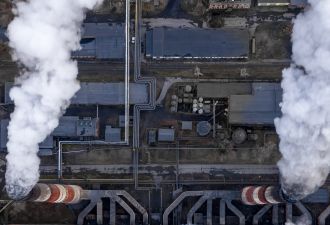Utilities operating fossil-fueled power plants, and the low-income and disadvantaged communities that face the brunt of their pollution, may have a new model for resolving their differences.
On Tuesday, the New York Power Authority signed a landmark agreement with the Peak Coalition, a group of five environmental justice and clean energy groups, to study ways to replace or reduce emissions from NYPA’s six gas-fired peaker plant sites in New York City and Long Island.
Tuesday’s memorandum of understanding doesn’t set a hard deadline for closing the plants, which provide about 470 megawatts of capacity to meet downstate New York’s peak-constrained grid needs. But it does offer communities at most risk from their emissions an ongoing role in working with the state’s public power utility to find cost-effective ways to reduce the impact, NYPA CEO Gil Quiniones said in a Wednesday interview.
“We exist for the benefit of the people of the state, and we’re fulfilling that mission,” he said. “We want to be a first mover; we want to lead by example.”
Balancing health and reliability
NYPA’s peaker fleet, installed in the early 2000s, doesn’t face the need to close by 2025 under state air-quality regulations, as do older, more polluting peaker plants in downstate New York. But they’ve been the target of legal challenges from groups representing low-income communities at most risk of harm from their emissions.
At the same time, New York City faces a shortage of transmission capacity to meet its peak grid demands, and NYPA’s units may become more valuable for meeting those needs as older plants face retirement, Quiniones said. They’re also important for local grid reliability, and several are needed for “black-start” capability to reenergize the grid after power outages, “so we have to be careful” about how to replace them, he said.
This is a common problem facing utilities in states such as New York that are pushing to decarbonize their electricity generation fleets, and it doesn’t have an easy answer. California regulators have allowed utilities to replace capacity from the closed San Onofre nuclear power plant with new gas-fired peaker plants, though they also required Southern California Edison and San Diego Gas & Electric to seek out batteries, energy efficiency and demand response to meet part of the shortfall.
More recent decisions have replaced new California gas plants with clean energy portfolios. At the same time, the state is extending the retirement dates of several coastal gas plants to ensure adequate grid reliability, despite strong opposition from surrounding communities exposed to their emissions, while it seeks to deploy solar, batteries and other low-carbon replacements.
Looking for "breakthrough technologies"
NYPA’s agreement with the Peak Coalition calls for a study of alternatives that can both ensure reliability and reduce the amount of emissions its peaker plants emit during the roughly 10 percent of the year they’re called into service, Quiniones said. Beyond NYPA’s in-house experts, “we’ll hire consultants and hire a sub-consultant to advise the environmental justice groups, so they know it’s not biased, that it’s fact-based,” he said.
“The first thing we’ll consider seriously is installing existing storage technology on a hybrid basis,” using batteries to augment power plant capacity, Quiniones said.
This approach is gaining popularity. Power producer AES is installing a 100-megawatt/400-megawatt-hour battery at its Alamitos power plant as it reduces the scale of its gas-fired generation there. In New York, LS Power plans to install 316 MW of batteries to replace combustion turbines at its Ravenswood Generating Station in Queens.
Today’s lithium-ion batteries can cost-effectively provide energy storage for between four to eight hours at a time, with costs rising as durations grow. NYPA is also responsible for assuring state ratepayers that it’s not choosing alternatives that will drastically increase the costs of its peaker facilities, particularly in today’s energy markets with their relatively low prices for natural gas and gas-fired electricity, Quiniones noted.
But as New York pursues its statewide goals of getting 70 percent of its electricity from renewable resources by 2030 and reaching zero-carbon electricity by 2040, more options will emerge, he said.
“There’s going to be a need for breakthrough technologies in a couple of areas,” he said. One is long-duration storage, a category that includes advanced batteries such as those being developed by Form Energy. The Massachusetts-based startup believes its batteries, paired with shorter-duration technologies, could replace 83 percent of New York’s peaking units — a lot more than the 6 to 11 percent of peakers that could be replaced by today’s battery options, according to a 2019 study by the consultancy Energy and Environmental Economics.
NYPA is also working with Zinc8 Energy Solutions to develop a zinc-air energy storage system meant to provide more than eight hours of storage duration.
Low-carbon fuels to replace fossil natural gas, such as hydrogen generated from clean electricity or synthetic gas combined with carbon-capture techniques, will be another longer-term tool, Quiniones said. NYPA is a member of the Low-Carbon Resources Initiative, a partnership with the Electric Power Research Institute and the Gas Technology Institute aiming to boost the efficiency and lower costs for these fuels.
These technologies are expected to play a major role in utility decarbonization efforts around the world. At the same time, utilities are facing increasing pressure to close fossil-fueled plants faster than most are currently planning to do, with low-income communities that disproportionately house them often leading the charge.
“In this time of racial reckoning and the growing harm from climate change to vulnerable populations, this New York agreement is a responsible model that should be followed in other communities with peaker plants, one where plant owners respect environmental justice concerns and pursue a collaborative approach to a clean energy transition in heavily polluted urban areas,” said Lewis Milford, president of nonprofit Clean Energy Group and Peak Coalition adviser, in a statement.




